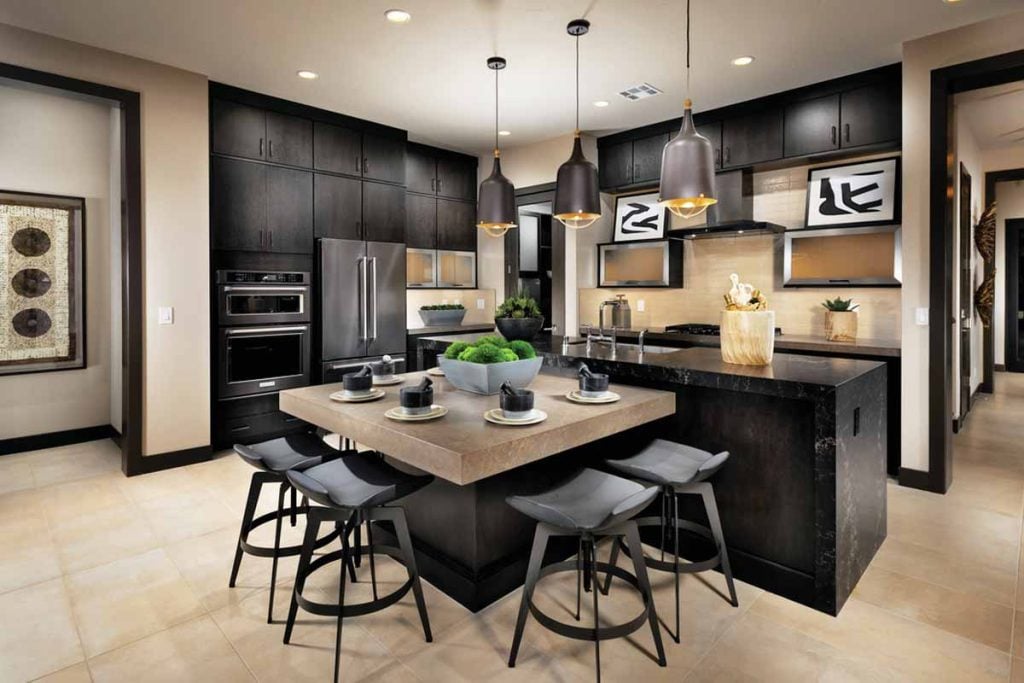The next wave in kitchens is clear, and the numbers are loud. The National Kitchen and Bath Association’s 2026 trends report, drawn from 600+ designers, contractors, and manufacturers, maps what will shape cook spaces over the next three years. Kitchens are getting larger and more central, so finishes must work harder. One countertop material now leads with style, durability, and ease, while traditional stones fade. Here’s what the pros say will rise—and why it matters.
Why Quartz Is the Countertop Material to Beat
Quartz tops the list for 78% of pros. It delivers the look of stone without the upkeep, since resin-bound surfaces resist stains, chips, and most splashes. Daily life is simpler, because maintenance is minimal. For families that cook often, this countertop material gives beauty, strength, and predictable performance.
Designers also point to its versatile style. Lighter counters with darker cabinetry read fresh and modern, while matte or honed textures feel calm. Waterfall islands remain strong, and edges range from squared to classic. Homeowners split on color mixing: 56% want the island to differ, while 44% prefer a perfect match.
Cabinet trends play along. White oak remains the favorite, with about half of pros predicting it as the top cabinet wood; walnut follows at 28%. European flat-panel doors lead, while Shaker stays close behind. Floor-to-ceiling storage and panel-ready appliances keep kitchens streamlined, so clean-lined quartz slabs fit right in.
What Sets Quartzite Apart in Daily Use
Quartzite ranks second because it is real stone with elevated durability. It handles heat better than many options and brings natural movement that reads refined, not busy. Surface sealing is smart, yet care stays straightforward when handled well. For cooks who want nature and strength, this countertop material earns its place.
Color direction supports quartzite’s quiet drama. Neutrals still dominate for 96% of pros, though green climbs at 86% and blue follows at 78%. Designers weave those hues into islands, stools, or backsplashes. Because quartzite often comes in warm, stony shades, it complements serene palettes while letting veining add gentle energy.
Finish choices shape the feel. A honed surface softens glare and highlights texture, while hand-sanded edges lend craft. Since quartzite is dense and heavy, planning matters, so measure clearances and confirm support. Coordinate the slab with cabinet tone and hardware sheen, then let lighting reveal subtle shifts across the polished minerals.
Why Granite Is Losing Ground as a Countertop Material
Granite’s share keeps slipping. Only 43% of respondents still see it as a major player. Many patterns feel busier than today’s streamlined preference, and frequent sealing turns into a chore. As open kitchens expand, easy-care surfaces win. People want fast cleanup, strong resistance, and visual calm across generous spans.
While granite remains durable, daily realities can be frustrating. Oily stains linger if sealed poorly, and some finishes show rings or etching from acids. Patterns that once read luxurious now clash with flat-panel cabinets and long sightlines. Because family zones blend together, owners favor materials that disappear when not in use.
Hardware shifts deepen the trend. Matte finishes extend to sinks, faucets, and lighting, so polished glare feels dated. Honed granite exists, yet supply and color choice can be limited locally. Granite still succeeds in rustic spaces or outdoor bars. Even so, quieter, low-maintenance alternatives fit today’s blended, flexible living.
Marble’s New Role in High-Impact, Low-Stress Kitchens
Marble keeps its aura, although only 26% of pros place it high on usage lists. It etches with acids and needs vigilant care, which clashes with busy routines. Used carefully, though, it radiates character. A single island slab turns heads, while the working perimeter relies on another countertop material.
That strategic mix protects looks and budget. Designers often pick a honed marble for the “wow” zone, then rely on quartz or quartzite where knife work and sauces fly. Softer edges feel crafted and less chip-prone. Because movement varies from whisper to bold rivers, homeowners can select drama or a whisper-quiet read.
Color stories keep marble relevant. Warm neutrals anchor the room, then green or blue accents bring life through stools, rugs, or art. Since transitional design leads at 72% and contemporary minimalism follows at 60%, marble becomes a sculptural accent rather than the workhorse. With sealing and trays, it ages more gracefully.
Backsplashes That Sync With Counters and Cabinet Trends
Tile still rules backsplashes for 70% of pros, thanks to durability and easy swaps. Yet slab backsplashes are rising fast: quartz reaches 64%, and quartzite hits 61%. A continuous surface wipes clean in seconds and extends the counter’s character upward, which supports the streamlined look many pair with a countertop material.
Warm neutrals steer the palette, while statement color appears with intention. Designers place saturated green or blue on the island, in wallpaper, or through accessories rather than across every wall. Because transitional remains the top style at 72%, with modern minimal at 60%, these choices keep rooms calm yet expressive.
The kitchen’s role keeps expanding, so function matters. Families request attached mudrooms, pet feeding stations, and study nooks near the action. Eat-in seating turns the island into a daily hub. Matte fixtures echo the soft sheen of honed counters. Shiny is out, because subtle finishes help large spaces feel restful.
What this shift means for confident choices that still feel personal
The data shows a clear path: pick durable finishes that lower stress and raise style. Lead with quartz for the hardworking zones, then layer natural stone for touchpoints you’ll cherish. Match light counters to deeper cabinets for balance. When a hero piece is marble, let another countertop material take the daily hits.
